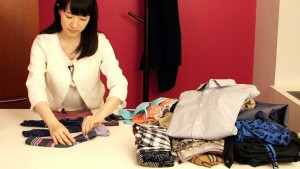Kondo mania! Or why I’m throwing away as many things as I can
 Sorry for the silence, but I am a woman possessed. I finally read Marie Kondo’s The Life-Changing Magic of Tidying Up: The Japanese Art of Decluttering and Organizing
Sorry for the silence, but I am a woman possessed. I finally read Marie Kondo’s The Life-Changing Magic of Tidying Up: The Japanese Art of Decluttering and Organizing. Kondo does something no other professional organizer does: She gives you permission to throw out just about everything.
All other organizing books tell you precisely what to throw out. Throw out clothes you haven’t worn in one year, or two years, or three years. Throw out financial statements that are more than “X” years old. Throw out pots without lids or lids without storage containers. And so on and so forth.
Then, they tell you precisely how to organize: For your remaining clothes, hang the shirts to the left and the pants to the right. Put the socks on the second from the bottom drawer, and make sure all your underpants are white or hot pink. File your papers away in green folders for paid bills and red folders for things the tax man will want. Separate them by year, month, day of the week, and hour. Stack your pots in precision rows and line your cutlery drawers. Of course, I’m never able to conform to any of those things, either because I have problems throwing away the items the book insists must be tossed or because the organization defeats me.
Up until Kondo’s book, the best organizing book I ever read was Julie Morgenstern’s Organizing from the Inside Out, Second Edition: The Foolproof System For Organizing Your Home, Your Office and Your Life, which I still look upon as an extremely valuable book. Morgenstern’s principle is that people don’t change their basic habits no matter what a book tells them to do. If you’re the kind of person who slips off your shoes the moment you enter the house (as I am), having your shoe storage area at the other end of the house is pointless; the shoes will never make that journey. The more intelligent thing to do is to have a shoe cubby at your point of entry. It may not be a thing of designer beauty, but it will be better than having shoes strewn higgledy-piggledy around the front hall.
Thanks to Morgenstern, I’m extremely organized in that I can put my hands on anything within five minutes. My problem, though, is that I still have way too much stuff. Some of it I bought, only to realize too late that the item wasn’t right for me. Some things I bought but they’ve worn out their usefulness. Most of the things that burden me, though, have come into my life as freebies, gifts, and hand-me-downs.
Putting all this stuff away, searching through it, and just being aware of its useless presence in my house weighs me down — but still, up until Kondo, I couldn’t make myself throw the things out. It just seemed so wasteful or, if the thing was a gift, disrespectful.
Kondo’s shtick is that, if something doesn’t bring you joy or have a strong utilitarian role in your life, throw it out. She says that you should empty everything out of your closet or cupboard or chest of drawers and then handle every single item. If you hold it in your hands and don’t feel pleasure, get rid of it.
Importantly for me, Kondo says that, when it comes to gifts, the gifts highest and truest moment as a gift is the moment it is given. That moment highlights the relationship between giver and receiver. After that, the gift is just another object. If you love it keep; if you don’t, get rid of it. After all, you’re not going to forget your beloved granny simply because you’ve decided that someone else might appreciate more than you do the garish Christmas sweater that’s been hiding in the back of your closet for 30 years.
My metric is a little bit different. Although I definitely am keeping things that give me joy, I’m also looking at things through a negative prism: When I pick up this object or that item of clothing, do I get a horrible feeling of ennui just thinking of the effort it will take to put it away? That too is a reason to toss. After all, a lot of things don’t bring me joy, but I can’t of like them, and don’t mind the effort of caring for them.
Over the past week, I’ve bagged for charity or thrown away 50% of my clothes. I will not forget my mother because the Salvation Army will get her used, but beautifully maintained, cashmere sweater from 1985. The reality is that it’s out of style, the wrong size, the wrong color, and it makes me itch — but someone else will be delighted with it.
Nor will my grandmother recede from memory because I’m also giving to charity the throw she knit. She didn’t knit it specifically for me. She just knit endless patchwork throws to keep her hands busy. They’re heavy, hard to wash and, again, make me itch. Surely there’s someone who will enjoy these blankets. I sure didn’t, since they’ve sat on top of my closet shelf collecting dust for 30 years.
I’ve also cleared out my pantry, cleaned my kitchen containers, done a clean sweep through my medicine cabinet, and purged all that make-up I never use. I’m having fun doing all this too. With every item that leaves the house, I feel lighter and more free. Whatever my future holds, it won’t be a future that sees me weighed down by useless objects.
